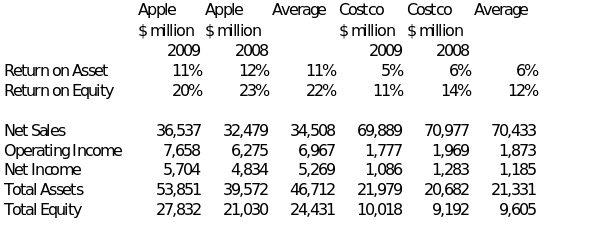Introduction
This paper seeks to compare Apple and Costco to decide which of the two companies is better to acquire for investment purposes. The financial statements for the last two years will be used to compute their profitability ratios and operating costs in relation to revenues and assets as basis for making a decision
Analysis and Discussion
Comparative profitability of Apple and Costco
Based on their profitable ratios, Apple is more profitable than Costco. Apple has a return on equity (ROE) of 23% in 2008 and 20% in 2009, or a slight decrease from the preceding year. Costco, on the other hand, has an ROE of 14% in 2008 and this also decreased to 11% in 2009. Thus, it could be assumed that the decrease in profitability of the retail industry is external in a cause. In other words, the global financial crisis has affected the retail industry because of the lower purchasing power of customers for the company’s products and services in 2009 as compared to 2008. See Figure 1.

The average return on equity (ROE) is higher for Apple than for Costco for the past two years. In fact, the difference is almost doubled in favor of Apple. It may be noted that return on equity uses the formula where net profit is divided by the total stockholders’ equity. When compared to an average rate of 0.25%, if money is invested in a bank, Apple’s present average ROE of 12% still makes it to more than twenty times as against Costco and therefore investors have reason to acquire the company or stay with the company.
Although Costco’s average ROE is still high at 6%, which is more than 20 times over that risk-free rate, it is more profitable to view Apple as it has higher ROE. The 0.25% benchmark is the US base rate of the Federal Reserve Bank that could represent the risk-free rate investment in the US (Housepricecrash.co.uk, 2009). The same could be used as an estimate of the opportunity cost of a company making an investment by acquisition or otherwise.
Comparative operating Cost of Apple and Costco
The operating costs of the two companies are also important in determining their profitability. The accounting concept provides that net income is computed by deducting the cost and expenses from revenues. Thus, the higher the operating cost in relation to revenues and all other things being held constant in relation to sales, the less would be the profitability of a company. Impliedly, between the two, Apple has better operating cost in relation to revenues than Costco because the former has higher profitability ratio. Relating operating cost to revenues in terms would have the same purpose as relating net income to revenues.
Another way of viewing also the relationship of cost to revenues is to relate costs or net income, to the total assets employed by the company in arriving at the net income of the companies. As stated earlier, Apple has a higher ROA than Costco and therefore necessarily, Apple should have less operating cost in relation to total assets as compared to Costco. In other words, Apple is more effective.
Conclusion
Between Apple and Costco, the first one should be chosen, as the same is more profitable as measured in terms of both ROA and ROE for the last two years. But for purposes of acquisition, what is profitable is not necessarily the better one to acquire without other information on the acquisition prices of the two companies. Thus, the more profitable may turn out to cost more, thus the decision should be compared with the acquisition cost or price so that the net advantage or net gain should be compared before one decides which of the two companies to acquire.
Reference
Apple (2010) 10-K Annual Report. Web.
Costco Whole Sale (2010) EC Filings 10-K Annual Report. Web.
Housepricecrash. (2010). US Federal Reserved Base Rate. Web.